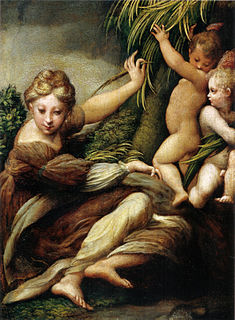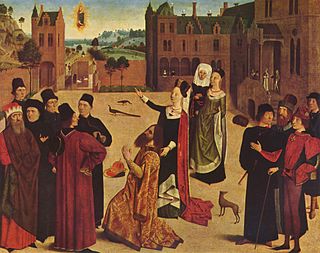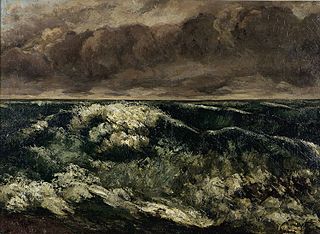 W
WAquis Submersus is a painting by the German dadaist and surrealist Max Ernst created in 1919. Influenced by the Italian metaphysical art it is one of Ernst's earliest works showing surrealistic accents. It currently resides at the Städel Museum in Frankfurt, Germany.
 W
WThe Blinding of Samson is a 1636 painting by Rembrandt, now in the Städel. The painting is the first of its kind in pictorial tradition. No other artist at the time had painted this specific narrative moment.
 W
WThe Croquet Game is an 1873 oil on canvas painting by Édouard Manet, now in the Städel Museum in Frankfurt. It shows a group of people playing croquet, a very fashionable game at that time. The group comprises the painter Alfred Stevens, artists' models Victorine Meurent and Alice Legouvé and, in the background, Manet's friend Paul Rodier.
 W
WEcce Homo is a painting of the episode in the Passion of Jesus by the Early Netherlandish painter Hieronymus Bosch, painted between 1475 - 1485. The original version, with a provenance in collections in Ghent, is in the Städel Museum in Frankfurt; a copy is held the Museum of Fine Arts in Boston. The painting takes its title from the Latin words Ecce Homo, "Behold the Man" spoken by the Roman Prefect Pontius Pilate when Jesus is paraded before a baying, angry mob in Jerusalem before he is sentenced to be crucified.
 W
WThe Eruption of Vesuvius is the name of several 1821 paintings by the Norwegian artist Johan Christian Dahl. He travelled to Italy in 1820, spending a short time in Rome before moving on to Naples, arriving in time for the eruption of Mount Vesuvius in December that year. He was one of the first to climb the mountain. There are at least seven versions of the painting, three are exhibited in the Danish National Gallery in Copenhagen, in the Kode Museum in Bergen and the final one in Städel Museum in Frankfurt.
 W
WFemale Martyr with Two Angels is a c.1523-1524 oil on panel painting by Parmigianino, now in the Städel Museum in Frankfurt, to which it was donated in 1913 by Baroness Emilie Margarethe Beaulieu-Marconnay, member of a family of bankers and art patrons in the city.
 W
WThe Geographer is a painting created by Dutch artist Johannes Vermeer in 1668–1669, and is now in the collection of the Städelsches Kunstinstitut museum in Frankfurt, Germany. It is closely related to Vermeer's The Astronomer, for instance using the same model in the same dress, and has sometimes been considered a pendant painting to it. A 2017 study indicated that the canvas for the two works came from the same bolt of material.
 W
WGoethe in the Roman Campagna is a painting by Johann Heinrich Wilhelm Tischbein, a German Neoclassical painter, depicting Johann Wolfgang von Goethe when the writer was travelling in Italy. Goethe's book on his travels to Italy from 1786–88, called Italian Journey, was published in 1816–17; the book is based on his diaries. Since 1887, the painting has been in the possession of the Städel Museum in Goethe's hometown Frankfurt.
 W
WThe Heller Altarpiece was an oil on panel triptych by German Renaissance artists Albrecht Dürer and Matthias Grünewald, executed between 1507 and 1509. The artwork was named after Jakob Heller, who ordered it. Dürer painted the interior, Grünewald the exterior.
 W
WThe Jabach Altarpiece is an oil on lime tree panel painting by German Renaissance artist Albrecht Dürer, executed around 1503–1504. Originally a triptych, only the side panels are now preserved: the right picture, measuring 96×54 cm, is housed in the Wallraf-Richartz Museum of Cologne; the left picture, measuring 96×51 cm, is housed in the Städel of Frankfurt.
 W
WJealousy is a painting by Norwegian artist Edvard Munch. Munch returned to this image throughout his whole life - he completed no less than 11 painted versions of Jealousy. The first painting was executed in 1895, and the last was made during the 1930s. Munch also created four lithograph versions and one drypoint of Jealousy.
 W
WThe Lucca Madonna is an oil painting by the Early Netherlandish master Jan van Eyck, painted in approximately 1437. It shows Mary seated on a wooden throne and crowned by a canopy, breastfeeding the infant Christ. Its carpentry suggests it was once the inner panel of a triptych, while its small size indicates it was meant for private devotion. The painting is in the collection of the Städel Museum, Frankfurt.
 W
WMadonna and Child with Four Doctors of the Church is a 1540-1545 oil on canvas painting by Moretto da Brescia, now in the Städelsches Kunstinstitut in Frankfurt. From left to right it shows Gregory the Great, Saint Jerome, Saint Ambrose and Augustine of Hippo.
 W
WMadonna and Child with the Infant John the Baptist is an oil on oak panel painting by Perugino, dating to around 1497 and now in the Städel Museum in Frankfurt-am-Main
 W
WThe Medici Madonna is an oil-on-panel painting by the Netherlandish artist Rogier van der Weyden, dating from around 1460–1464 and housed in the Städel, Frankfurt, Germany.
 W
WThe Paradiesgärtlein is a panel painting created around 1410 by an unknown painter referred to as Upper Rhenish Master. It belongs to the Mary in the rose bower type. The Paradiesgärtlein is one of the earliest paintings to naturalistically depict flora and fauna
 W
WPortrait of a Man in a Red Hat is an 1465-1470 oil on oak panel painting by Hans Memling, one of the first portraits he produced in Bruges, with similarities to his Portrait of a Man - its subject is unknown. It has some similarities to portraits by Jan van Eyck and Rogier van der Weyden, though the fictive stone frame is Memling's invention.
 W
WPortrait of a Young Woman is a painting which is commonly believed to be by the Italian Renaissance painter Sandro Botticelli, executed between 1480 and 1485. Others attribute authorship to Jacopo da Sellaio. The woman is shown in profile but with her bust turned in three-quarter view to reveal a cameo medallion she is wearing around her neck. The medallion is a copy in reverse of "Nero's Seal", a famous antique carnelian representing Apollo and Marsyas, which belonged to Lorenzo de' Medici.
 W
WSaint Mark is a 1448 tempera on canvas painting by Andrea Mantegna. It is now in the Städel Museum in Frankfurt. It is the earliest known work by the artist.
 W
WThe Master of the Tiburtine Sibyl was an unidentified Early Netherlandish painter, probably from Haarlem, named after The Tiburtine Sibyl meets Augustus, a work in the Städel in Frankfurt.
 W
WThe Wave or The Waves is the title given to several seascapes painted between 1869 and 1870 by the French painter Gustave Courbet.